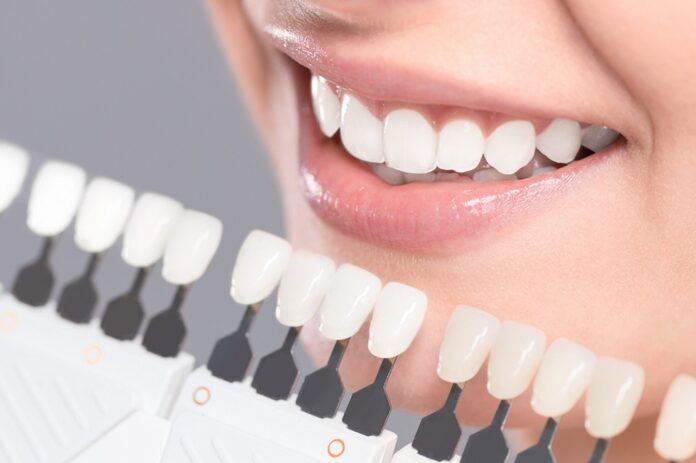The best way to make teeth seem better is by using dental veneers. Veneers come in two varieties: composite and porcelain.
The two materials most frequently utilized in the manufacture of veneers are composite resin and porcelain, but how can you know which one is best for you?
An extremely thin shell known as a dental veneer is affixed to the front surfaces of one or more teeth by your dentist.
Your demands, tastes, and the advice of your dentist will all play a role in the choice of material.
To ensure the durability of veneers, check with your dentist to see whether you are a good candidate. Furthermore, practice good oral hygiene practices and schedule frequent dental checkups.
Porcelain Venners Vs. Composite Veneers – Understanding The Differences
Here we shall help you understand the difference between porcelain veneers and composite veneers in multiple sections:
What Are They?
Dental porcelain veneers are little pieces of porcelain that are bonded to the tooth’s surface.
They are a well-liked cosmetic dentistry solution that may aid in restoring the aesthetics of teeth that are stained, cracked, or out of alignment.
They may be used to fix a number of aesthetic issues, such as tooth gaps, chipping, and discoloration.
You can also use them to restore your existing teeth rather than getting an implant or denture to replace them.
Using composite resin, composite veneers are a minimally invasive kind of tooth covering.
They are a fantastic solution for people who wish to enhance the appearance of their teeth without having a major dental procedure.
They may be finished in only one dental appointment and are perfect for repairing minor chips or teeth fissures.
Unfortunately, they could not last as long as porcelain veneers and eventually needed to be touched up or replaced.
Difference In Durability
Although composite veneers normally last 4 to 8 years, porcelain veneers should last 10-15 years.
Regular dental checkups and cleanings, refraining from bad habits like nail-biting and chewing on hard objects, and being conscious that veneers may eventually need to be changed due to wear and tear or changes in the natural teeth are all examples of proper maintenance.
Composite veneers are more resistant to chipping but less sturdy than porcelain and more brittle.
For people who favor price and simplicity of maintenance, the composite may be a better choice than porcelain if they want a durable, natural-looking alternative.
This dentist who does the best dental implants in Lexington also adds that when a porcelain veneer is chipped, it has to be completely replaced. On the other hand, when a composite veneer gets chipped, it can be repaired through bonding.
Difference In Aesthetics
Those who enjoy coffee, tea, or red wine will find porcelain veneers the perfect option because they are transparent and stain resistant.
They are dependable and, with the right upkeep and care, may last for many years, making them an excellent long-term investment for anyone wishing to enhance their smile.
However, they are not reversible, so you should speak with a dentist to figure out which is ideal for your particular requirements and price range.
Difference In Costs
Although more expensive than composite veneers, porcelain veneers are more lasting, stain-resistant, and give teeth a more realistic appearance because they may approximate the translucency of natural teeth.
They may be finished in a single appointment to the dentist and are less expensive than composite since they are more resilient to stains and more durable than composite.
The final decision between composite and porcelain will be based on the person’s financial situation, personal preferences, and dental requirements. To learn more, visit Premier Dentistry at Millennium Park.
What Are The Advantages Of Using Porcelain Veneers?
While composite veneers provide many benefits, porcelain remains a durable option.
Porcelain veneers may be finished in only one dental appointment, are less costly, and can last 10 to 15 years.
When determining which kind of veneer to acquire, it’s crucial to consider the person’s financial situation and availability because composites can cost half as much as porcelain but only last half as long.
Porcelain, which delivers the most realistic, tooth-like looks and is resistant to discoloration and chipping, is generally agreed upon by dentists as the best value.
While it is more complicated and necessitates wearing temporaries while the veneers are being created in a lab, more and more dentists are adopting chairside CAD/CAM technology that facilitates a quicker procedure.
All cases of worn enamel, wear, and tear, genetic flaws, uneven teeth, etc., can be successfully treated with it.
What Are The Advantages Of Using Composite Veneers?
Compared to porcelain veneers, composite veneers have a lot of benefits, including being twice as costly and requiring less tooth enamel to be removed.
Direct composite veneers are placed right on the teeth, allowing the dentist to mold and sculpt them.
A high-intensity light is used to cure the formed resin, after which more resin can be added and molded as necessary.
Polishing the resin is necessary to provide a more realistic, tooth-like look. They are also often more affordable and available, making them a more accessible choice.
Your dentist can help you choose the type of veneer that best suits your unique needs and objectives.
Different Types Of Dental Veneers
Other than porcelain and composite veneers, there are some more categories that you can consider—
No-Prep Veneers
The least invasive permanent alternative for people who wish to enhance their smile without having substantial dental procedures is no-prep veneers, like Lumineers.
They cover the tooth without changing it since they comprise a flexible, very thin material.
Some people choose Lumineers over porcelain veneers since they don’t require any tooth shaving and are less expensive.
Nevertheless, they might not be appropriate in every situation, so speaking with a dentist is crucial to determine the best course of action.
They can last about as long as composite veneers, although they become less durable over time. Before making a choice, it is crucial to explore your alternatives with your dentist.
Removable Veneers
A more recent alternative to entering the market is removable veneers, constructed of a thin composite or porcelain material and may be applied over natural teeth without causing any long-term changes to the tooth structure.
They provide a less expensive and intrusive alternative for people who wish to whiten their teeth without committing to permanent veneers.
Nevertheless, these products are not advised for everyday usage because they can trap plaque and germs and eventually cause gum damage.
Before making any decisions, it’s crucial to consider the long-term repercussions of utilizing pseudo-veneers and speak with a dentist.
Veneers Treatment
Porcelain and composite resin veneers are applied in different ways. Veneers made of porcelain need two appointments.
To make room for the veneers, the dentist will remove some tooth enamel at the initial session.
The veneer will be bonded to the outside of each tooth during the second session using cement and a special light to harden them. You may now enjoy your beautiful smile after removing any excess material.
Read Also
- Modern Approaches to Adolescent Mental Health Treatment for Lasting RecoveryWith increasing numbers of teens experiencing emotional and behavioral health concerns, adolescent mental health treatment has become more essential than ever. Conditions such as anxiety, depression, trauma and mood instability are on the rise, and effective support must evolve with these growing needs. Today’s treatment models blend evidence-based therapy with flexible access and holistic care, giving… Read more: Modern Approaches to Adolescent Mental Health Treatment for Lasting Recovery
- How to Find a 5-Star Dentist Near YouChoosing a dentist is more than just finding someone who can clean your teeth. It’s about selecting a trusted partner in your long-term oral health. A 5-star dentist not only provides excellent clinical care but also delivers a positive patient experience, from the moment you walk in until the moment you leave. Whether you’re new… Read more: How to Find a 5-Star Dentist Near You
- Your Easy-Peasy Guide to Brewing Amazing MatchaHey there! So, you’ve heard all the buzz about matcha – that vibrant green powder that’s not just pretty but packed with good stuff? It can seem a little fancy and intimidating at first, but trust me, making a delicious cup at home is simpler than you think. Forget complicated ceremonies for now; let’s just… Read more: Your Easy-Peasy Guide to Brewing Amazing Matcha
- Embracing Holistic Wellness: Insights from a Lansing, MI Health CenterReframing Health: Moving Beyond Symptom Management Treating only symptoms often offers quick relief, yet long-term results stay out of reach. When care zeroes in on isolated complaints, the bigger picture, such as stress, behavior, or lifestyle, often gets missed. Research shows that whole-person care, which looks at physical, emotional, and environmental factors, yields better outcomes… Read more: Embracing Holistic Wellness: Insights from a Lansing, MI Health Center
- VO₂ Max Testing Explained: What It Is & Why It Matters for Your HealthVO₂ max sounds like a term reserved for elite athletes, but it’s among the most accurate measures of your lifetime and general condition. Moreover, it goes beyond performance. Monitoring your VO₂ max will help you to ascertain your body’s capacity to control stress, its oxygen consumption efficiency, and your internal ageing process. If you have… Read more: VO₂ Max Testing Explained: What It Is & Why It Matters for Your Health






